In the world of arachnids, few creatures evoke as much curiosity and wonder as the Daddy Long Legs. These delicate, graceful creatures are often misunderstood and surrounded by myths. Despite their common presence in many regions of the world, there’s still much to uncover about these fascinating arachnids. In this comprehensive blog post, we embark on a journey to explore the intricate world of Daddy Long Legs.
Where Does the Daddy Long Legs Get Its Name From?
The term “Daddy Long Legs” is used to refer to several different creatures, including certain species of arachnids, insects, and even crane flies. However, when specifically referring to the arachnid, it’s typically the harvestman that comes to mind.
The common name “Daddy Long Legs” likely originates from the creature’s distinctive appearance, particularly its long, slender legs compared to its small body. The term “daddy” may have been used colloquially to signify something large or impressive, while “long legs” is a straightforward description of its physical feature.
It’s worth noting that in different regions or cultures, Daddy Long Legs may be called by various names, but the term has become widely recognised and used to describe these intriguing arachnids.
Taxonomy and Classification
Daddy Long Legs belong to the order Opiliones, distinct from spiders despite common misconceptions. While they share some similarities with spiders, they have unique characteristics that set them apart taxonomically.
Anatomy and Physical Characteristics of the Daddy Long Legs
Body Structure
Daddy Long Legs typically have small, rounded bodies segmented into two main parts, the cephalothorax, and the abdomen.
Legs
Their most distinctive feature is their long, slender legs, which can be several times longer than their bodies.
Eyes
Contrary to popular belief, Daddy Long Legs possess eyes and have relatively good eyesight, though they rely more on touch and vibration to sense their environment.
Daddy Long Legs Habitat and Distribution
Daddy Long Legs are found in various habitats worldwide, ranging from forests and grasslands to urban environments. They prefer damp, dark areas where they can find shelter and prey.
Feeding Habits
Despite their predatory appearance, Daddy Long Legs are primarily scavengers and opportunistic hunters. They feed on a variety of small invertebrates, carrion, and organic matter found in their environment. Their diet includes insects, spiders, and even decaying plant material.
Reproduction and Life Cycle
Mating
Daddy Long Legs engage in elaborate courtship rituals, where males often perform intricate dances or display behaviours to attract females.
Egg-laying
Females typically lay eggs in moist soil or leaf litter, where they hatch into tiny, leggy nymphs.
Development
Daddy Long Legs undergo incomplete metamorphosis, meaning they hatch from eggs as miniature versions of adults and moult several times before reaching maturity.
Daddy Long Legs Defence Mechanisms
They possess several defence mechanisms to evade predators and survive in their environment.
How the Daddy Long Legs Camouflages Itself
Their slender bodies and ability to remain motionless help them blend into their surroundings, making them less conspicuous to predators.
Fragile Leg Autotomy
When threatened, Daddy Long Legs can detach their legs, allowing them to escape from predators. Remarkably, they can regenerate lost legs during subsequent moults.
Myths and Misconceptions About the Daddy Long Legs
Daddy Long Legs have long been the subject of myths and misconceptions, including the belief that they are highly venomous or deadly to humans. In reality, Daddy Long Legs possess no venom glands, making them harmless to humans.
Ecological Importance
Predators
Despite their small size, Daddy Long Legs play a crucial role in controlling insect populations, serving as natural predators to many pests.
Decomposers
As scavengers, Daddy Long Legs contribute to the decomposition process by feeding on decaying organic matter, thereby recycling nutrients back into the ecosystem.
Daddy Long Legs’ Cultural Significance
Daddy Long Legs have appeared in various cultural contexts, often symbolising traits such as adaptability, resilience, and patience. They have been featured in folklore, literature, and art, reflecting humanity’s fascination with these enigmatic creatures.
Conclusion
Daddy Long Legs, with their ethereal appearance and intriguing behaviours, continue to captivate the imaginations of people around the world. Through our exploration, we’ve uncovered the diverse facets of these arachnids, shedding light on their biology, behaviour, and ecological significance. As we unravel the mysteries of this arachnid, we gain a deeper appreciation for the intricate wonders of the natural world.








No Comments